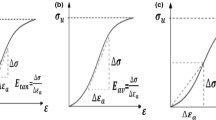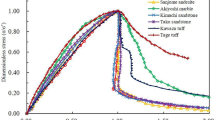Conclusions
The deformational properties of traditional EMs, based on quartz sand, are completely specified.
Firstly, the modulus of elasticity of the material is significantly higher than the modulus of deformation.
Secondly, strictly speaking, the deformation modulus itself is not a constant, but depends on the stress level.
Thirdly, the moduli of deformation and elasticity depend to differing degrees on the previous loading history, in particular on preliminary cyclic trials. As the number of trial cycles increases, both these parameters merge in magnitude. It is assumed that the specific nature of the deformational properties of EM result from the high porosity of the materials.
The author wishes to thank Profs. G. N. Kuznetsov and F. P. Glushikhin for valuable discussion and advice in the course of this work.
Similar content being viewed by others
Literature Cited
G. N. Kuznetsov, M. N. Bud'ko, Yu. I. Vasil'ev, et al., Modeling of Rock Pressure Manifestations [in Russian], Nedra, Leningrad (1968).
The Technical and Methodologic Demands of Modeling with Equivalent Materials [in Russian], VNIMI, Leningrad (1973).
Methodologic Instructions for Investigating Manifestations of Rock Pressure in Equivalen Material Models [in Russian], VNIMI, Leningrad (1976).
Methodologic Instructions for the Technical Preparation and Determination of Physicomechanical Properties of Equivalent Materials [in Russian], VNIMI, Leningrad (1980).
A. M. Lin'kov, “Calculation of postlimiting deformations in a plane problem about a circular mine working,” Fiz.-Tekh. Probl. Razrab. Polezn. Iskop., No. 5 (1977).
Yu. M. Kartashov, B. V. Matveev, G. V. Mikheev, and A. A. Fadeev, Rock Strength and Deformability [in Russian], Nedra, Moscow (1979).
G. M. Kerch, V. G. Bunin, and L. A. Irgen, “Influence of a dispersed filler on the modulus of elasticity of glasslike composites,” Mekh. Polim., No. 5 (1979).
A. K. Malmeister, V. P. Tamuzh, and G. A. Teters, Strength of Polymers and Composite Materials [in Russian], Zinatne, Riga (1980).
A. A. Berlin and V. E. Basin, Foundations of Polymer Adhesion [Russian translation], Khimiya, Moscow (1974).
Additional information
All-Union Scientific-Research Institute of Rock Mechanics and Underground Surveying (VNIMI), Leningrad. Translated from Fiziko-Tekhnicheskie Problemy Razrabotki Poleznykh Iskopaemykh, No. 5, pp. 15–22, September–October, 1982.
Rights and permissions
About this article
Cite this article
Zlotnikov, M.S. Deformation of equivalent materials. Soviet Mining Science 18, 367–373 (1982). https://doi.org/10.1007/BF02528440
Received:
Published:
Issue Date:
DOI: https://doi.org/10.1007/BF02528440




